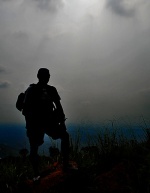Palawan is not just about El Nido, Coron or Honda Bay–to the more adventurous traveler anyway…
Located 174km northwest of Puerto Princesa City (PPC), the sleepy fishing village of San Vicente is about four hours away by van. If you are coming in from Port Barton–the municipality’s more “touristy” barangay, and home to several resorts and lodging houses–you can reach San Vicente in 45 minutes via motorized banca. I took the PPC-San Vicente direct route because it is faster and more convenient, with several trips a day beginning at 4AM. On the other hand, there is only one trip per day going to Port Barton and it leaves at 9AM.
San Vicente is touted by many as “the next Boracay”. It is home to the country’s longest contiguous beach, aptly named Long Beach, an 8km stretch of undeveloped, unexploited virgin beach–the entire island of Boracay, from end to end, is only 7km long! Many believe the beach stretches 14km, but looking at the sattelite imagery on Google Earth, this can only be possible if you include the beaches of Bokbok, Tagpis, Alimanguan, and Boong.

Other interesting places to check out in San Vicente are Daplac Cove in Boayan Island; Inamuran Island; New Capari, Kemdeng and Tangdan beaches; and the islands off the coast of Port Barton.
Daplac Cove, Boayan Island

Daplac Cove is owned and managed by Palawan Cove Corp., a private institution. Palawan Cove, the LGU of San Vicente, and the DENR set up a coral nursery in the clean, calm waters of Daplac Cove, where several varieties of endemic corals are cultivated and grown.

The waters of Daplac is home to several species of marine life which includes a huge school of matang-baka, some sea turtles, a 4-foot long black-tip shark, a manta ray, and many more. I was very fortunate to have been given the chance to explore its underwater residents.

The cove’s powdery soft sand is a welcome treat to tired feet..

A welcome break…
Tangdan Beach and Palawan Camping site

By far, this islet just across Tangdan Beach is my favorite! Locals call it “Palawan Camping”. I call it heaven!

Stonehenge?

This islet has some of the most spectacular rock formations…

… it makes you think you’re in Eastern Samar.

..Nope. This ain’t Biri Island.

Walking on Tangdan’s powdery off-white-close-to-beige sand makes you miss…

… Boracay!

But, I like it here better than Boracay.

Peace. Quiet.
Kemdeng Beach
Port Barton and nearby islands
To fully realize San Vicente’s tourism potential, infrastructure development is in full swing: an international airport is being constructed near the former Inandeng airstrip; the Itabiak road is being rehabilitated and widened, and construction of a bigger wharf is underway.
Personally though, I really hope San Vicente doesn’t turn into another Boracay. The island–and beaches–of Boracay is undoubtedly world-class, lovely and all that, but given its highly commercialized transformation, Boracay has become an ecological nightmare; which, I seriously hope won’t happen to San Vicente once it opens up its doors to the influx of tourists.



















 Every time we experience something for the first time — our first kiss; our first embrace, our first love — that moment is frozen in our memory forever. Even our first view of a spectacular sunrise or a poignant sunset is indelibly imprinted in our minds. And, floating among these most-cherished reminiscences are images of the very first trip we took with our husband, our wife, our boyfriend or girlfriend, or someone very dear to us.
Every time we experience something for the first time — our first kiss; our first embrace, our first love — that moment is frozen in our memory forever. Even our first view of a spectacular sunrise or a poignant sunset is indelibly imprinted in our minds. And, floating among these most-cherished reminiscences are images of the very first trip we took with our husband, our wife, our boyfriend or girlfriend, or someone very dear to us.





















































